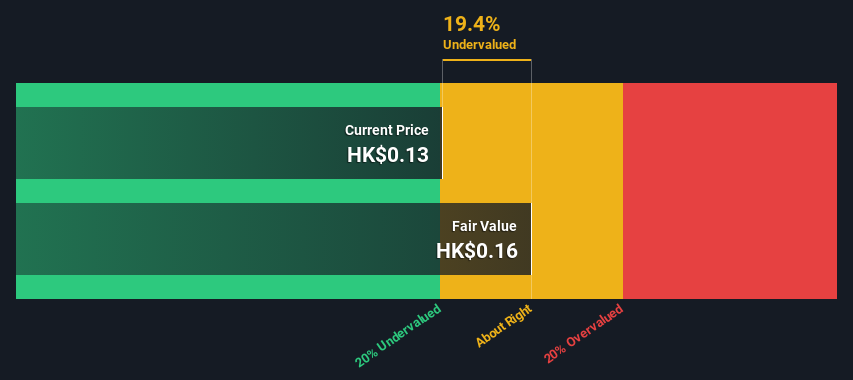- Hong Kong
- /
- Entertainment
- /
- SEHK:1740
A Look At The Fair Value Of Values Cultural Investment Limited (HKG:1740)

Key Insights
- The projected fair value for Values Cultural Investment is HK$0.16 based on 2 Stage Free Cash Flow to Equity
- Values Cultural Investment's HK$0.13 share price indicates it is trading at similar levels as its fair value estimate
- Values Cultural Investment's peers are currently trading at a premium of 54% on average
In this article we are going to estimate the intrinsic value of Values Cultural Investment Limited (HKG:1740) by taking the forecast future cash flows of the company and discounting them back to today's value. Our analysis will employ the Discounted Cash Flow (DCF) model. Don't get put off by the jargon, the math behind it is actually quite straightforward.
Companies can be valued in a lot of ways, so we would point out that a DCF is not perfect for every situation. For those who are keen learners of equity analysis, the Simply Wall St analysis model here may be something of interest to you.
Check out our latest analysis for Values Cultural Investment
The Calculation
We are going to use a two-stage DCF model, which, as the name states, takes into account two stages of growth. The first stage is generally a higher growth period which levels off heading towards the terminal value, captured in the second 'steady growth' period. To begin with, we have to get estimates of the next ten years of cash flows. Seeing as no analyst estimates of free cash flow are available to us, we have extrapolate the previous free cash flow (FCF) from the company's last reported value. We assume companies with shrinking free cash flow will slow their rate of shrinkage, and that companies with growing free cash flow will see their growth rate slow, over this period. We do this to reflect that growth tends to slow more in the early years than it does in later years.
Generally we assume that a dollar today is more valuable than a dollar in the future, and so the sum of these future cash flows is then discounted to today's value:
10-year free cash flow (FCF) estimate
| 2024 | 2025 | 2026 | 2027 | 2028 | 2029 | 2030 | 2031 | 2032 | 2033 | |
| Levered FCF (CN¥, Millions) | CN¥5.42m | CN¥6.60m | CN¥7.65m | CN¥8.55m | CN¥9.31m | CN¥9.95m | CN¥10.5m | CN¥11.0m | CN¥11.4m | CN¥11.7m |
| Growth Rate Estimate Source | Est @ 30.24% | Est @ 21.82% | Est @ 15.92% | Est @ 11.79% | Est @ 8.90% | Est @ 6.87% | Est @ 5.46% | Est @ 4.46% | Est @ 3.77% | Est @ 3.28% |
| Present Value (CN¥, Millions) Discounted @ 8.0% | CN¥5.0 | CN¥5.7 | CN¥6.1 | CN¥6.3 | CN¥6.3 | CN¥6.3 | CN¥6.1 | CN¥5.9 | CN¥5.7 | CN¥5.4 |
("Est" = FCF growth rate estimated by Simply Wall St)
Present Value of 10-year Cash Flow (PVCF) = CN¥59m
After calculating the present value of future cash flows in the initial 10-year period, we need to calculate the Terminal Value, which accounts for all future cash flows beyond the first stage. The Gordon Growth formula is used to calculate Terminal Value at a future annual growth rate equal to the 5-year average of the 10-year government bond yield of 2.2%. We discount the terminal cash flows to today's value at a cost of equity of 8.0%.
Terminal Value (TV)= FCF2033 × (1 + g) ÷ (r – g) = CN¥12m× (1 + 2.2%) ÷ (8.0%– 2.2%) = CN¥205m
Present Value of Terminal Value (PVTV)= TV / (1 + r)10= CN¥205m÷ ( 1 + 8.0%)10= CN¥95m
The total value, or equity value, is then the sum of the present value of the future cash flows, which in this case is CN¥154m. The last step is to then divide the equity value by the number of shares outstanding. Relative to the current share price of HK$0.1, the company appears about fair value at a 19% discount to where the stock price trades currently. Remember though, that this is just an approximate valuation, and like any complex formula - garbage in, garbage out.

Important Assumptions
Now the most important inputs to a discounted cash flow are the discount rate, and of course, the actual cash flows. If you don't agree with these result, have a go at the calculation yourself and play with the assumptions. The DCF also does not consider the possible cyclicality of an industry, or a company's future capital requirements, so it does not give a full picture of a company's potential performance. Given that we are looking at Values Cultural Investment as potential shareholders, the cost of equity is used as the discount rate, rather than the cost of capital (or weighted average cost of capital, WACC) which accounts for debt. In this calculation we've used 8.0%, which is based on a levered beta of 1.067. Beta is a measure of a stock's volatility, compared to the market as a whole. We get our beta from the industry average beta of globally comparable companies, with an imposed limit between 0.8 and 2.0, which is a reasonable range for a stable business.
Moving On:
Valuation is only one side of the coin in terms of building your investment thesis, and it is only one of many factors that you need to assess for a company. It's not possible to obtain a foolproof valuation with a DCF model. Rather it should be seen as a guide to "what assumptions need to be true for this stock to be under/overvalued?" For example, changes in the company's cost of equity or the risk free rate can significantly impact the valuation. For Values Cultural Investment, there are three additional items you should further research:
- Risks: You should be aware of the 3 warning signs for Values Cultural Investment (1 is concerning!) we've uncovered before considering an investment in the company.
- Other Solid Businesses: Low debt, high returns on equity and good past performance are fundamental to a strong business. Why not explore our interactive list of stocks with solid business fundamentals to see if there are other companies you may not have considered!
- Other Environmentally-Friendly Companies: Concerned about the environment and think consumers will buy eco-friendly products more and more? Browse through our interactive list of companies that are thinking about a greener future to discover some stocks you may not have thought of!
PS. Simply Wall St updates its DCF calculation for every Hong Kong stock every day, so if you want to find the intrinsic value of any other stock just search here.
New: Manage All Your Stock Portfolios in One Place
We've created the ultimate portfolio companion for stock investors, and it's free.
• Connect an unlimited number of Portfolios and see your total in one currency
• Be alerted to new Warning Signs or Risks via email or mobile
• Track the Fair Value of your stocks
Have feedback on this article? Concerned about the content? Get in touch with us directly. Alternatively, email editorial-team (at) simplywallst.com.
This article by Simply Wall St is general in nature. We provide commentary based on historical data and analyst forecasts only using an unbiased methodology and our articles are not intended to be financial advice. It does not constitute a recommendation to buy or sell any stock, and does not take account of your objectives, or your financial situation. We aim to bring you long-term focused analysis driven by fundamental data. Note that our analysis may not factor in the latest price-sensitive company announcements or qualitative material. Simply Wall St has no position in any stocks mentioned.
About SEHK:1740
Values Cultural Investment
An investment holding company, engages in the production, distribution, and licensing of broadcasting rights of television (TV) and web series in Mainland China.
Adequate balance sheet low.
Market Insights
Community Narratives



